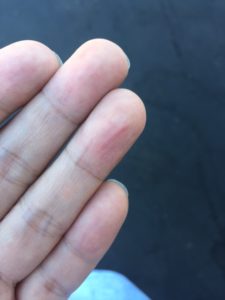Yesterday, I was rushing through a shipping task and clumsily sliced open my ring finger to about a 1.5mm depth. Predictably, blood came gushing out and so I put some alcohol in it and wrapped it up with micropore tape.
 Less than 24 hrs later, after doing yoga handstands on it and taking 3 capsules of containing Recharge, I un-bandaged the finger to find this:
Less than 24 hrs later, after doing yoga handstands on it and taking 3 capsules of containing Recharge, I un-bandaged the finger to find this:
It seemed odd because I remember what a finger laceration used to entail. There would be disunion, a scab that would form, and perhaps days to weeks of a remodeling and weakened scar. I can’t help but think that accelerated local stem cell replication helps healing, perhaps because telomere restoration is a potential rate-limiting-step in healing.
Interestingly, when you do fetal surgery, the baby is usually born without scarring. I would guess that the lack of bacteria, mechanical stress, and anti-inflammatory cytokines help. But could it also be that the quality of the local and progenitor stem cells is higher and that this efficiency represents not only a lack of differentiation but a paucity of epigenetic and genetic commitment and its attendant inflexibility?
Many clients taking adaptogens report rapid healing but I would like to compare and contrast with an email I received from a patient this week who was going to quit TA-65 because he had muscle aches and a sore Achilles’ ligament:
I took 8 daily for 2 weeks and experienced negative symptoms including a variety of muscle stiffness issues and also I developed Achilles pain in thesame time.
I had a similar loss of faith and some faulty attribution with my own Achilles’ years ago and I blogged about it here.
To learn more about Achilles’ ligament injuries, watch this podcast that I did.
In a nutshell, I thought the TA-65 was causing the problem but stopping made it worse and doubling my dose made it go away. So how can I reconcile that? Well, my patient and I both felt there was a relationship but we failed to see what was underlying- the injury to the tendon.
Because the tendon was injured, the inflammation, repair, and mechanical compromise were heightened. Instead of being a fixed constant, the acceleration of repair also left the ligament prone to re-injury. Sort of like not waiting for concrete to dry before walking on it.
Interestingly, I often find that muscle and tendon soreness in the first two weeks of starting an adaptogen a very auspicious sign in my patients. The majority of people correctly recall an old injury and they report that the pain resulted in a new normal of no pain after a few days – in other words, old scars were being remodeled and younger, better cells and connective tissue were being laid down.
So a word to the wise: pain is not weakness leaving the body. It is a sign that there is inflammation and something that is easily reinjured if you don’t pay heed. Adaptogens can’t change the physics of movement or repair but I believe they can accelerate the normal processes; but you can’t walk on wet concrete and not expect to leave some footprints. Watch this video on sports injury for more info:

